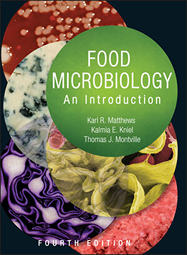Food Microbiology an Introduction
Material type: TextLanguage: English Publication details: Washington, DC : ASM Press, ©2017Edition: 4thDescription: XVIII, 597 p. : illISBN:
TextLanguage: English Publication details: Washington, DC : ASM Press, ©2017Edition: 4thDescription: XVIII, 597 p. : illISBN: - 9781555819385
- 664.001579 MAT
| Item type | Current library | Shelving location | Call number | Copy number | Status | Date due | Barcode |
|---|---|---|---|---|---|---|---|
 Reference Collection
Reference Collection
|
Seminar Library | Department of Food Engineering | 664.001579 MAT | 2022-23 | Available | 98077 |
About the Author
Karl R. Matthews is a professor of microbial food safety at Rutgers University. He received a PhD from the University of Kentucky in 1988. Dr. Matthews has earned an international reputation for his work on the interaction of foodborne pathogens with fresh fruits and vegetables. This includes demonstrating the internal localization of bacteria during growth of leafy greens. He further showed that the internalization process is a passive event by demonstrating the internalization of fluorescent polystyrene beads. Dr. Matthews has also been active in research on antimicrobial resistance of foodborne bacteria and development of novel antimicrobial agents.
Kalmia E. Kniel is a professor of microbial food safety in the Department of Animal and Food Sciences at the University of Delaware She received her PhD from Virginia Tech in Food Science and Technology in 2002. Her doctoral work focused on protozoan parasites. After that, she was a postdoctoral microbiologist at the USDA Agricultural Research Service's Animal Parasitic Diseases Laboratory. She is nationally recognized as a leading expert in transmission of viruses, protozoa, and bacteria in the preharvest environment. Dr. Kniel has been active in researching the mechanisms behind the survival and inactivation of norovirus, hepatitis A virus, and other enteric viruses in our water and foods. She is an active advocate for teaching food safety at all levels and has been involved with elementary and secondary education. At the University of Delaware, she teaches courses on foodborne outbreak investigations and the basics of food science and food safety from farm to fork.
Thomas J. Montville is a distinguished professor emeritus at Rutgers University, where he received his BS in 1975. Dr. Montville received his PhD from the Massachusetts Institute of Technology (MIT) and then worked at the U.S. Department of Agriculture (USDA) as a research microbiologist before returning to Rutgers as a professor. He has published over 100 research papers on Clostridium botulinum, Listeria monocytogenes, antimicrobial peptides, and Bacillus anthracis. Dr. Montville is a fellow of the American Academy of Microbiology and a fellow of the Institute of Food Technologists.
SUMMARY:
The multidisciplinary nature of food microbiology is one of the things that make it so fascinating as a career. Food microbiologists must understand basic microbiology, the roles of beneficial microbes, food safety regulations and policy, and the proper practices that ensure safe and healthy food for billions of people. They must also be nimble thinkers, willing to embrace new analytical methods, eager to solve problems, and ever vigilant about keeping the food supply safe.
The fourth edition of Food Microbiology: An Introduction is designed for undergraduate courses in food science, nutrition, and microbiology. This edition has been substantially updated with new information on topics like the Food Safety Modernization Act and the use of bacteriophage as antimicrobial agents, while retaining the pedagogy that students and professors appreciate. Written in a clear and easy-to-understand style, the textbook is divided into four sections:
Basics of food microbiology presents the growth processes of food microorganisms, the biology of spores and sporeformers, and the establishment of microbiological criteria in food safety programs, and it introduces students to some of the methods used to detect and enumerate microbes in food and food handling equipment. Foodborne pathogenic bacteria opens with a discussion about the regulatory agencies and surveillance systems responsible for keeping the United States food supply safe. The remainder of the section is a rogue's gallery of pathogenic bacteria found in food.
Other microbes important in food examines the many beneficial and detrimental ways that microorganisms affect our food supply. The section opens with a look at numerous foods, like beer, bread, pickles, and cheeses, created by the fermentation reactions of lactic acid bacteria and yeast. The rest of the section looks at microbes that are less desirable: the spoilers of food, toxigenic molds, and foodborne parasites. This section closes with a look at viruses and prions.
Control of microorganisms in food discusses the tactics used to inhibit microbial growth in food. The section ends with a chapter on the essentials of developing quality sanitation and HACCP programs in food processing facilities.
